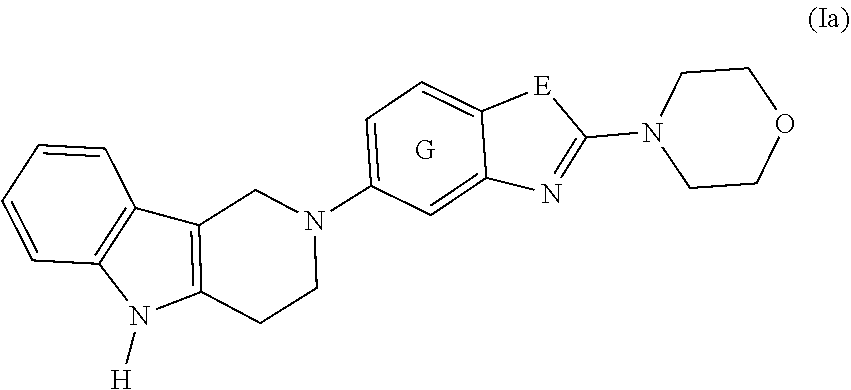Novel Compounds for the Treatment, Alleviation or Prevention of Disorders Associated with Tau Aggregates
a technology of tau aggregates and compounds, applied in the field of new compounds for the treatment, alleviation or prevention of disorders associated with tau aggregates, can solve problems such as specificity and toxicity, and achieve the effects of facilitating tau clearance, reducing or preventing the associated cognitive deficit, and high capacity to reduce tau aggregates
- Summary
- Abstract
- Description
- Claims
- Application Information
AI Technical Summary
Benefits of technology
Problems solved by technology
Method used
Image
Examples
example 2
Preparative Example 2
[0133]
[0134]Step A
[0135]To a solution of 3-(fluorophenyl) hydrazine (1 g, 6.1 mmol) and tert-butyl 4-oxopiperidine-1-carboxylate (1.2 g, 6.1 mmol) in 1,4-dioxane (10 mL) was added conc. H2SO4 (1 mL) at 0° C. Then the reaction mixture was warmed to 25° C. and heated at 110° C. for 3 h. The reaction mixture was cooled to room temperature and the precipitate was filtered off. The solid was dissolved in water, basified with NaOH solution and extracted with dichloromethane. The organic phase was separated and dried over Na2SO4 and the solvent was removed to afford the mixture of regioisomers as a pale yellow solid (0.65 g, 56%).
[0136]MS: 191.1 (M+H)+.
[0137]1H-NMR (400 MHz, DMSO-d6) δ=10.87 (bs, 1H), 7.26-7.30 (m, 1H), 7.02-7.05 (m, 1H), 6.74-6.79 (m, 1H), 3.83 (bs, 2H), 2.99-3.02 (m, 2H), 2.65-2.66 (m, 2H).
[0138]Step B
[0139]To a solution of the mixture of regioisomers (0.65 g, 3.15 mmol) in THF was added di-tert-butyl dicarbonate (0.757 g, 3.47 mmol) and the mixture ...
example 3
Preparative Example 3
[0160]
[0161]Step A
[0162]To a solution of (2-chloro-3-fluorophenyl)hydrazine (10 g, 62.5 mmol) and tert-butyl 4-oxopiperidine-1-carboxylate (12 g, 62.5 mmol) in 1,4-dioxane (100 mL) was added conc. H2SO4 (10 mL) at 0° C. Then the reaction mixture was warmed to 25° C. and heated at 110° C. for 3 h. The reaction mixture was cooled to room temperature and the precipitate was filtered off. The solid was dissolved in water, basified with NaOH solution and extracted with dichloromethane. The organic phase was separated and dried over Na2SO4 and the solvent was removed to give the title compound as a pale yellow solid (10 g, 72%).
[0163]MS: 225 (M+H)+.
[0164]1H-NMR (400 MHz, DMSO-d6) δ=11.23 (bs, 1H), 7.27-7.28 (m, 1H), 6.94-6.96 (m, 1H), 3.82 (s, 2H), 2.98-3.00 (m, 2H), 2.68 (d, 2H).
[0165]Step B
[0166]To a solution of the title compound from Step A above (10 g, 44.5 mmol) in THF (100 mL) was added di-tert-butyl dicarbonate (10.5 g, 46.5 mmol) and the mixture was stirred f...
example 4
Preparative Example 4
[0181]
[0182]Step A
[0183]To a stirred suspension of NaH (7.65 g, 60% mineral oil, 0.191 mol) in dry THF (100 mL) at 0° C., a solution of commercially available tert-butyl 1,3,4,5-tetrahydro-2H-pyrido[4,3-b]indole-2-carboxylate (18.0 g, 0.0637 mol) in dry THF (100 mL) was added slowly and stirred at the same temperature for 60 min. Then a solution of p-toluenesulfonyl chloride (15.8 g, 0.0828 mol) in dry THF (10 mL) was added dropwise at 0° C., and the reaction mixture was allowed to stir at 0° C. for 3 h. After completion of the reaction (monitored by TLC), the reaction mixture was cooled to 0° C. and quenched with ice water (40 mL), followed by extraction using ethyl acetate (200 mL×3). The combined organic extracts were washed with water (100 mL), brine (100 mL) and dried over Na2SO4. The organic layer was filtered and evaporated under reduced pressure to afford the crude product which was triturated with hexane (100 mL). The solid thus obtained was filtered, w...
PUM
| Property | Measurement | Unit |
|---|---|---|
| Composition | aaaaa | aaaaa |
| Aggregation | aaaaa | aaaaa |
Abstract
Description
Claims
Application Information
 Login to View More
Login to View More - R&D
- Intellectual Property
- Life Sciences
- Materials
- Tech Scout
- Unparalleled Data Quality
- Higher Quality Content
- 60% Fewer Hallucinations
Browse by: Latest US Patents, China's latest patents, Technical Efficacy Thesaurus, Application Domain, Technology Topic, Popular Technical Reports.
© 2025 PatSnap. All rights reserved.Legal|Privacy policy|Modern Slavery Act Transparency Statement|Sitemap|About US| Contact US: help@patsnap.com



